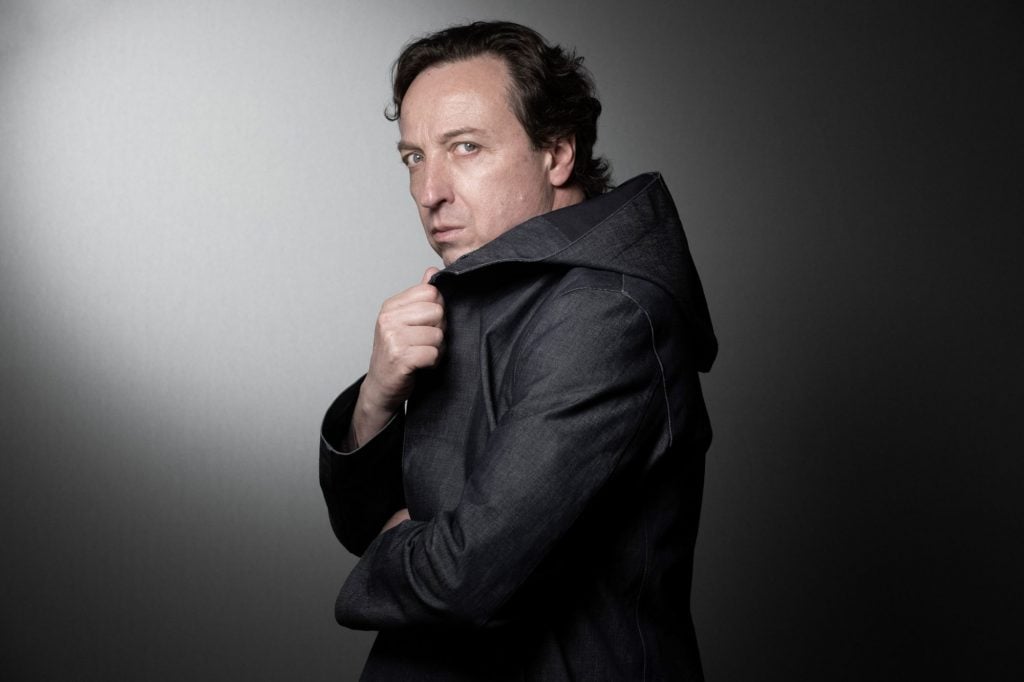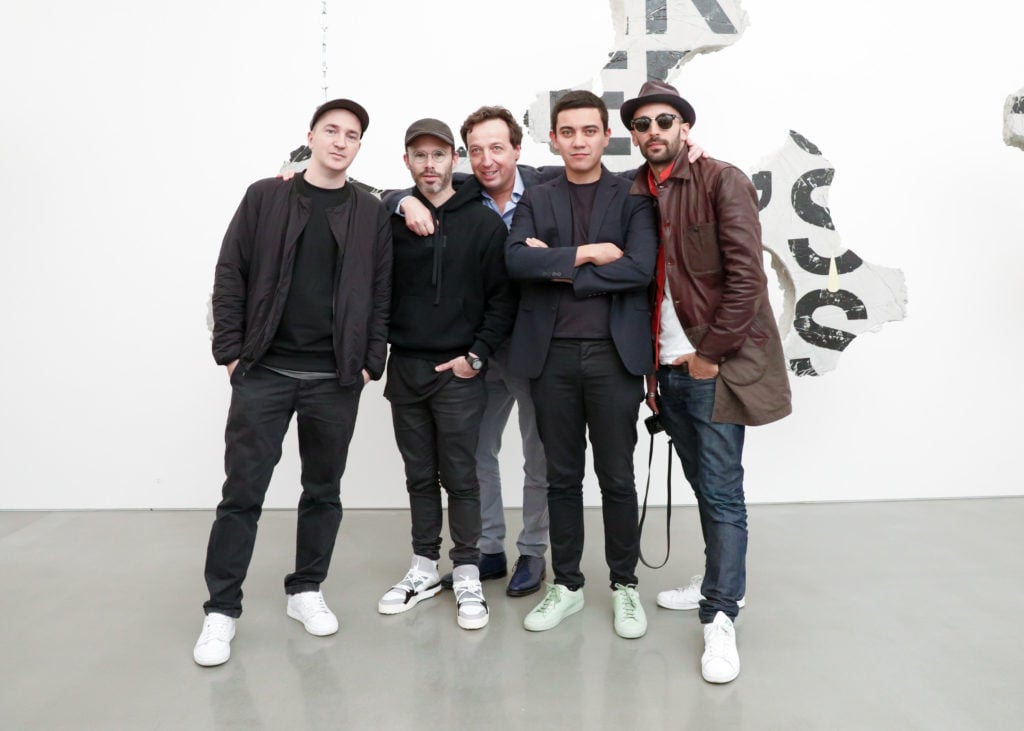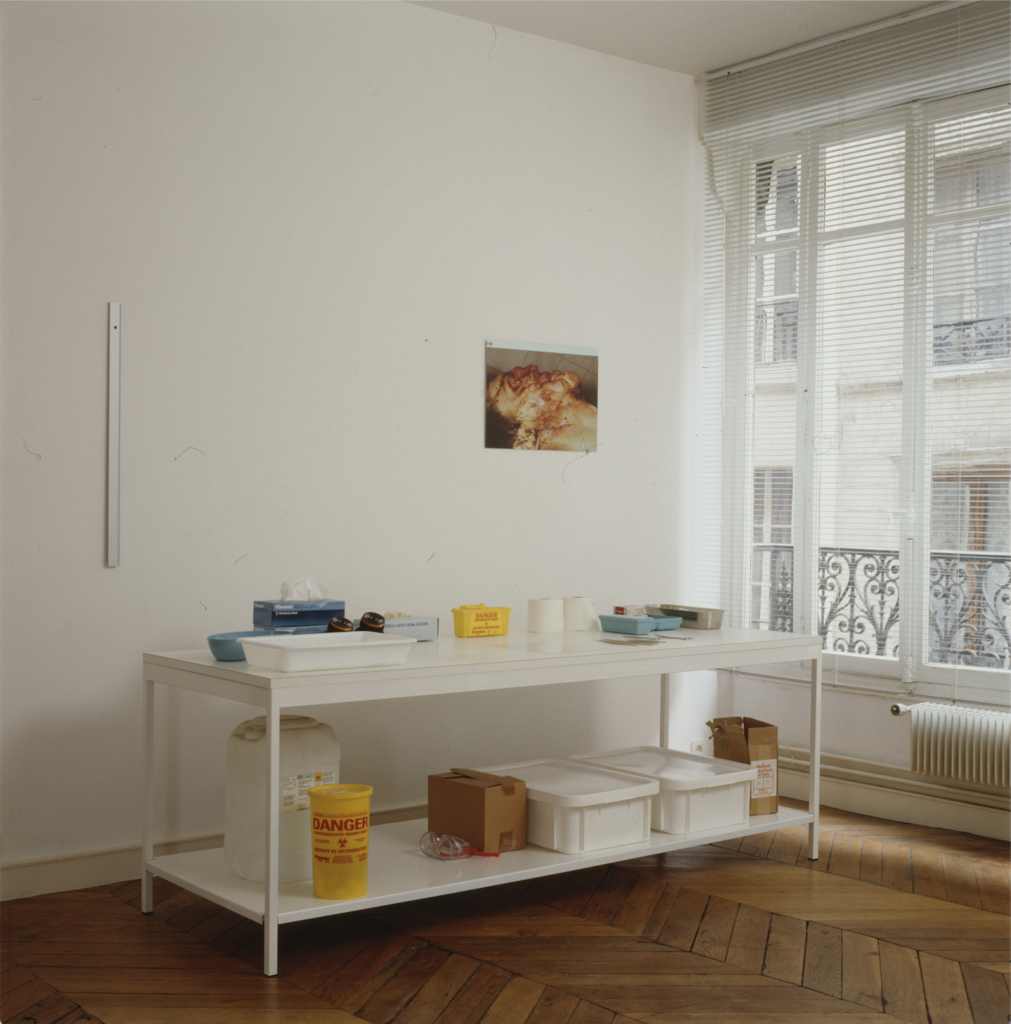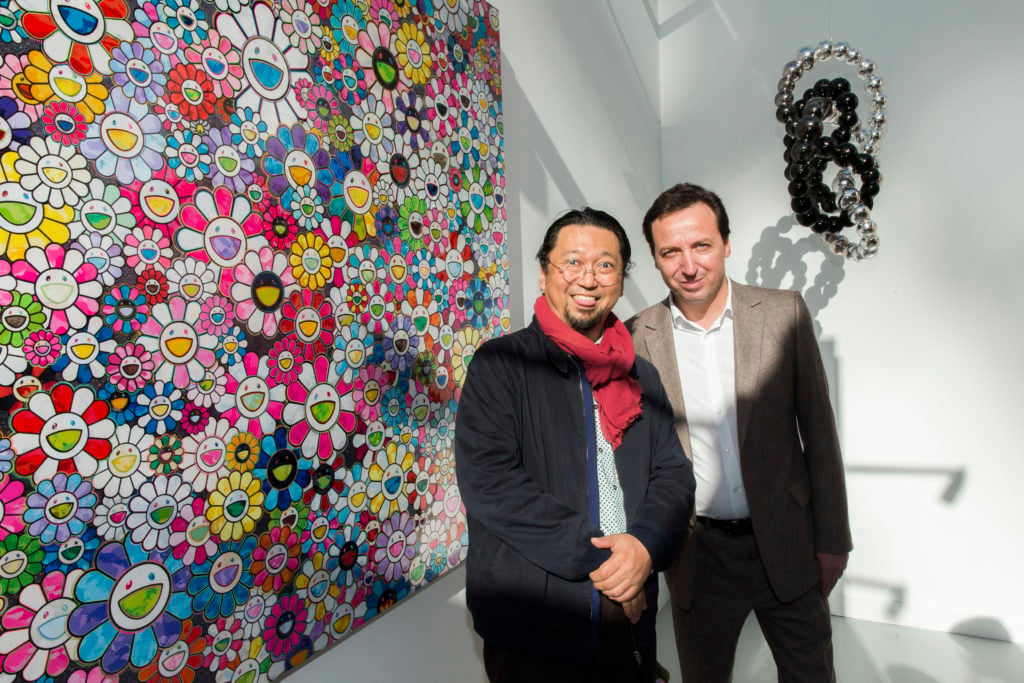People
Not Just a Party Boy: How Emmanuel Perrotin Became One of the Most Significant Dealers of the 21st Century
We speak to the energetic gallerist Emmanuel Perrotin about Damien Hirst, Murakami, and the origins of his gallery.

We speak to the energetic gallerist Emmanuel Perrotin about Damien Hirst, Murakami, and the origins of his gallery.

Andrew Goldstein

These days, when people think of the Paris-born, globe-spanning dealer Emmanuel Perrotin, two notions come to mind: KAWS (aka Brian Donnelly, the cartoon-inspired former street artist championed by Perrotin whose art market has lately become a head-turning global phenomenon), and parties. In fact, the Gallic gallerist is so closely associated with the glimmering surface of the art scene that the New York Times headlined a recent profile of him “Paris Art Dealer Brings the Party to New York” and declared that Perrotin “treats the global art market like a giant soirée.”
But stick around until the party is over, get to know the gallery a bit, and a surprising fact emerges: Perrotin is one of the most influential art dealers of the new millennium. In fact, he’s been a pivotal force in shaping the trajectory of the art world today as it evolves from a boutique, elite business into a global, mass industry.
The dealer who gave Damien Hirst his first commercial show, Perrotin has over the past two decades turned Takashi Murakami, Maurizio Cattelan, KAWS, JR, Daniel Arsham, and others into major stars by embracing an open, experimental ethos vis-à-vis brand collaborations, slingshotting these intrepid members of his roster into a far vaster marketplace. Known for taking lavish risks on his artists, he has also championed older, more traditional French painters like Pierre Soulages and Claude Rutault (Georges Mathieu is the latest), and last year—when he turned 50—he was decorated by French Culture Minister Françoise Nyssen as a member of the Ordre des Arts et des Lettres. (He even accompanied President Emmanuel Macron to the White House for the state dinner.)
That said, it’s admittedly not easy to forget about the parties, which are deeply woven into the DNA of the gallery. When I called Perrotin earlier this week at his Paris office, the hold music played “Happy” by Pharrell Williams (a key gallery ally and collaborator), and found the dealer in a somber mood, mourning the tragic accidental death of his close friend, the electronic-music legend Philippe “Zdar” Cerboneschi, who only two weeks prior had deejayed Perrotin’s annual party during Art Basel. The party was the last one Zdar—whose portrait hung in the gallery’s FIAC booth last year—ever did.
Here, in the first installment of a two-part interview, I speak to Perrotin about the unlikely rise of his business from a teenage side project to a powerhouse with four locations in Asia—Hong Kong, Seoul, Shanghai, and Tokyo—making it one of the most significant galleries in that emerging region, and the world.

04. KAWS, Daniel Arsham, Emmanuel Perrotin, Ivan Argote and JR at Perrotin New York, 2017
© BFA.com
One thing I’ve noticed is that many profiles of you foreground the parties that you throw at your gallery, framing you as a kind of Steve Rubell of the art world. I think the parties are actually a red herring for what makes you such a interesting figure—that you are quite a serious and innovative businessman. The parties are just the surface.
I’m very happy to organize a nice party—but it’s not the key to the success of my gallery. You can have the best party ever, but if you have a bad program, if you give bad advice to your artists, if you don’t make good catalogues, you will still be a loser. I’m sometimes shocked by how much attention this aspect of the gallery gets. But I’m sincere when I organize parties—that might be the difference with some brand that doesn’t care so much but feels they have to do it.
OK, let’s talk about how your business actually operates—and to do that, let’s go back to the beginning. You were a teenager from a middle-class suburban family outside Paris when you somehow got the idea to go work in the art world. How did that happen?
When I was 17, I was not very certain about what I wanted to do. I was trying to organize concerts, I was doing videos for bands, and I was connected to fashion because I was going out dancing at night. Some people make a caricature of the nightlife craziness, but I was not drinking and I was not taking drugs—that’s how I was able to go out and to work. I was also going to see contemporary dance, theater, movies—I was exploring many aspects of cultural life.
I came to a gallery in Paris—the first art gallery I had been to in my life—and I realized that it only opened at 2 p.m. So I thought, “Wow, fantastic”—if I worked for a gallery, I could have a stable job during the day and I would still be able to continue all my little parallel jobs and find out which one is right for me. One week later, a girlfriend introduced me to a half-Swedish, half-British dealer named Charles Cartwright who was only 23 years old and was going to school at the same time as he was running a gallery in Paris. And he asked me to do his schoolwork!
I said okay, and I came back the next day with the result of my work and I was received by the director of the gallery, a lady I had never met before, and she said, “Oh, you are Emmanuel? Charles told me about you, it’s fantastic you are here—take the key, take the alarm code, and close the gallery at 7 p.m. and then come back tomorrow to give me the key.” It was around 3 p.m., I was alone in the gallery, and I started like that. The next day she told me she needed help, and had asked Charles to bring me on.

Perrotin opened his first gallery in 1989, the year that IM Pei unveiled his Louvre pyramid. (Photo by Eric BOUVET/Gamma-Rapho via Getty Images)
This was your big break, and from then on things went pretty quickly, with you eventually opening your own gallery in the living room of your apartment when you were 21. What was this time like for you?
I was super lucky that Charles Cartwright was a very good art dealer. I was in a gallery that was doing solo shows of Alighiero Boetti and Marina Abramović, and we had Basquiat in a group show—Basquiat was selling for $10,000 at the time. I helped George Condo find an apartment in Paris. Let me tell you a romantic story: one day I was on a night train between Paris and Venice when I met a young lady in the restaurant, and she said, “You don’t remember me, but I met you when you were 18 and my father told me that one day you would be a very important art dealer.” “Who was your father?” She answered, “Alighiero Boetti.” You know who else he told this to? [The curator] Hans Ulrich Obrist, who I didn’t know at that time.
After one week at the gallery, I understood that the art world was my place. You were at the frontier of every other artistic activity. Video was close to cinema, performance art was close to theater, Sophie Calle was close to literature. I was close to fashion, too, because I would let designers like Hedi Slimane use my apartment gallery as a showroom in exchange for clothes—that was how I got my clothes. So you didn’t have to decide which you wanted to pursue. You were connected to everything.
It’s interesting how much of your gallery’s early success was propelled by your appetite for going out every night but also staying relatively straight-edge, keeping your wits about you. Is it true that you’ve never really drank much alcohol?
I do drink a little from time to time, but I get drunk very quickly so I don’t do it very much. When I was young I was surrounded by many brilliant people who drank and took drugs and I saw them have so many problems, so I’ve always stayed far from that. Trust me—it makes your art life complicated sometimes, when you’re hanging out with artists who want to drink. But later, it’s better for them because they’re happy that you manage things well and don’t just want to enjoy the art life. In a way, I was fortunate not to have the money to do that—I had to always be working. When I started 35 years ago, many art critics and gallerists were from good families, and it was quite difficult to be in the art world and not be from a good family, including artists, to be honest.
It still is difficult.
It’s gotten better because the internet has done a lot to give access to the art world. When I started it was really, really hard. Remember, back then even to send out images of an exhibition—which we did with slides—cost a fortune, and I would send them with another stamp in the envelope so I could get back my slides. It’s much easier now to be able to communicate to the rest of the world that you have talent.
How did you manage to cover all these costs back then?
I was doing many jobs in parallel to working at the gallery and I was living very frugally.
What were some of the side jobs?
I was helping other dealers find gallery spaces in Paris in exchange for one month of rent. I was delivering letters from the city hall of my parents’ hometown to every mailbox on the weekends. And at the age of 18, I started doing software programming to create catalogues raisonnés for artists from other galleries.
How did you learn software programming?
From the age of 15, I started doing data entry for the Musée d’Orsay, creating interactive slide shows—it was very primitive but at the time it was extraordinary for people. So then I started doing the catalogues raisonnés and then later I created my own program to manage the gallery, using the first generation of Filemaker. Now we have 10 programmers at the gallery working on it.

Damien Hirst’s first show in Perrotin’s living room in 1991. Photo courtesy of Perrotin Gallery.
Damien Hirst has said you gave him his first commercial show. How did you meet, and what was in it?
I met Damien through artists who connected me with two young dealers in London, Carl Freedman and Billee Sellman. The solo show was an autopsy room with a scalpel, formaldehyde, and photographs of people who had committed suicide, including people who had shot themselves. I had to take out my bed from the closet every night, so I was sleeping in the middle of the autopsy room. The show is included in every book about Damien. We were selling it for a very reasonable price, and then six months later—it was so fast—he started to become a very big star.
It was too fast for me. When you are a very young dealer, it is best to spend many years together without success, like I did with [Maurizio] Cattelan and [Takashi] Murakami, and to be able to show how dedicated you are and the kinds of risks you are willing to take. But when you have a young artist who becomes an international star six months after you start working with them, you become a very small story in the artist’s career. In many ways, I was really the beneficiary of my short relationship with Damien, and today we are still friends.
But I was ambitious to agree to do that show, especially considering that my own brother died of suicide six or seven years before the show, and I had to tell my parents, “Please don’t come to this show.” But my father came—he wanted to see why I didn’t want him to come—and an older dealer introduced himself to my father and told him, “Oh, my poor man, I don’t think he’ll be able to sell anything from this show.” But it was OK.
At some point you then met Maurizio Cattelan. How did that happen?
I went to an opening in Milan and I met a man with strong energy and I decided to show him. He intrigued me from the very beginning—every work was very different from the other. It was one of the key moments of my career for sure.
It was his force of personality that appealed to you?
Yes, his personality and the art that he described to me. At that time, an artist got a lot more feedback as a griot—you know, a storyteller—because it was pre-iPhone. I was able to talk about Maurizio’s work for hours without a single picture, to excite people just through the story.
Then you met Murakami at an art fair in Yokohama. What made you go all the way to Yokohama for an art fair?
That’s just the way it is when you don’t have money. Masami Shiraishi, who has a gallery called SCAI the Bathhouse, liked what I was doing and gave me a booth in an art fair for free. So I was staying in a very bad neighborhood in Yokohama, and I had brought all of my artworks in my suitcase as well as books and t-shirts and other merchandise to sell if I wanted to eat something. I was showing Maurizio and Damien, and now I look back and think I was crazy to take all these risks—if I didn’t sell from a show I would be bankrupt. But I discovered many artists and eventually became one of the more important Japanese galleries [laughs] because I’ve shown many Japanese artists over the years.
So Murakami came up to your booth?
He was excited by the fact that I was selling inexpensive stuff. We exchanged our fax numbers and I sent him three questions in English and he sent back 11 pages of answers written as cartoons.

Artist Takashi Murakami and galerist Emmanuel Perrotin attend the opening of the 40th edition of the FIAC International Contemporary Art Fair.(Photo by Bertrand Rindoff Petroff/Getty Images)
Fast forward to 2007, when Murakami did his famous collaboration with Marc Jacobs at Louis Vuitton. That sent shockwaves through the art world—people couldn’t believe an artist would do anything so blatantly commercial—and its popularity helped rewrite the rules for how artists could interact with a general mass audience. What role did you play in that collaboration?
I was not involved in the beginning. Louis Vuitton always worked very secretly to keep everything under wraps before they released a project. We didn’t know that this was going to completely change the way that that people approached collaborations. It was very unusual for the time. I started to encourage collaborations with fashion to put contemporary art a little more on the map in France, because people were not so interested in it then. But just last week, we had Daniel Arsham doing a major collaboration with Dior. Some artists are absolutely not suited for this kind of project, but for others it’s fantastic. We have to help make the choice—that’s an important part of our job.
Of course, there was still a stigma about art working with fashion because of the lingering ‘90s idea of “selling out.”
It was the same with artists working with fashion magazines—it was a compromise. And I had to explain to them, “Look, now it’s actually the opposite. You can be more creative in a fashion magazine than in an art magazine.” So step by step, they changed their minds and decided that they’d rather be in Dazed and Confused than just to do another interview with an art magazine, where they’d give you a small article and the fashion magazine would give you a big one.
Now a year later, in 2008, Hirst and Murakami underwent a fascinating transformation when each of them crossed over to an astonishing new level of visibility and financial success—Hirst with his Sotheby’s auction, and Murakami with the record $15 million sale of his Lonesome Cowboy at Sotheby’s in New York on the heels of his Louis Vuitton collaboration and MOCA show—that seemed to open a dark portal into a new universe of possibilities and scale. They went through that portal, and since then the rest of the art world has gradually been following them. How would you explain what’s been happening here?
The school year of 2008 to 2009 was the worst and best year of my life. The worst, because while I was suddenly selling a lot of work, it was followed by a very traumatic moment when I became almost bankrupt and people told me that I had to draw down my gallery if I wanted to survive. And I decided to do the opposite. I said, “OK, everyone is going to be very conservative now, so this is the moment for us to take risks.” So that was when we got half a page in the New York Times for a piece that we produced by Takashi and Pharrell Williams at Art Basel. That was when we really started to try some new things, and it took the gallery to a different level.